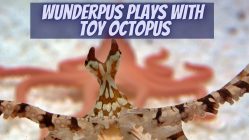It is hard to imagine a marine animal such as the octopus having a beak. In our mind, we usually associate beaks with birds. In fact, many dictionaries refer to the beak as the hard, projecting structure which is the mouth of the bird.
Nevertheless, the beak is not a feature restricted to birds. All cephalopods, including the octopus, have a two-part beak hidden inside their mouths.
A Lethal Weapon

The mouth of the octopus is not easily discerned, as it is hidden in the middle of the web that connects the eight arms of the octopus. But this hidden and small part of the octopus is, in fact, a lethal weapon.
The beak of the octopus is retractile and hard. It looks very similar to the beak of the parrot. It is made of chitin and it is an extremely powerful and useful tool. It is sharp enough to tear the flesh of the prey apart and competent enough to break the shells of clams open. Behind the beak, we find the octopus salivary gland where the poison is being produced and from where it is being released to the victim through the beak.
The Parts Of The Beak

As mentioned above, the beak is composed mainly by two parts, which are called the upper beak and the lower beak.
Both of these parts, in turn, are composed by two main components: the outer layer, which is called the hood and the inner layer, which is called the wall. These two layers are held together by two additional parts, called the bridge and the shoulder. The bridge and the shoulder are not fixed parts, but rather flexible, allowing the beak to move in a way similar to a pair of cutting scissors.
Inside The Beak - The Radula

The mouth of the octopus also has a tongue, called the radula. The radula is located between the beak and the poison gland. It is used to scrape the meat of the victim out of its shell. As the octopus’ favourite treats include crabs and other crustaceans, the radula is a very handy organ.
Just below the radula, the octopus possesses one more useful tool, the salivary papilla. The papilla is muscular and its front side is covered with very small teeth. Imagine a drill able to release a weakening substance as it gradually opens the way into the shell of the prey. What a deadly tool indeed!
The Remains Of A Meal

The beak of the octopus is indigestible, which means that it does not disintegrate in the stomach of the octopus’ predators. As the octopus does not have bones or other hard parts except from the beak, the beak is the only way to tell if the octopus is included in an animal’s diet.
Therefore, the beak is very useful in identifying the dangers that the octopus faces by unveiling all of its predators. Moreover, it gives scientists a very accurate picture of the role and position of the octopus, as well as of the rest of the cephalopods, in an ecosystem. For example, although it has never been witnessed, we known that sperm whales feed on Giant Squid as many of their beaks have been found in their stomachs.
Beak Size Matters

Finally, beaks are important as they can reveal information about the octopus even when the octopus is no longer around. By measuring the length of both parts of the beak (upper and lower), scientists can calculate the mantle length as well as the weight of the octopus.
This kind of information may also be used to illustrate the past of the cephalopods, how and when octopuses evolved, and how big or small were the octopus species that no longer exist. Naturally, it is a very difficult task to identify a cephalopod based on its beak. Experts must have previously recorded data of a species’ beak to be able to draw comparisons. There are still many octopus species for which scientists have been able to measure only the beaks of younger individuals or for which there are still no recorded measurements whatsoever.
Beaks and their size matter if we wish to unravel the mystery of the octopus and its species.












